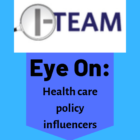By Christopher Hoffman
Although Gov. Ned Lamont said nothing about health care policy in his inaugural speech to the General Assembly, it’s likely to be a major theme of at least his early months in office.
Why? Depending on how it’s calculated, health care makes up 25 to 30 percent of the state budget, according to the Office of the State Comptroller. Lamont will have to balance the need to save money with the desire of many inside and outside the General Assembly to expand and improve health care coverage and lower costs for consumers.
“There’s almost two levels,” said Patricia Baker, president and CEO of the Connecticut Health Foundation, which focuses on assuring health equity and access to affordable care for all. “One is the issues that are emerging at the legislature. The other is the state budget and how it affects the issues in play.”

Lamont’s transition team did not return calls asking about his health care agenda, but interviews with a broad swath of state government officials, lawmakers, lobbyists and advocates yielded a long list of issues, including controlling the skyrocketing prescription drug prices—20 senators have proposed a bill to make prescription medication more affordable. Other issues include: exploring creation of a health insurance public option—Senate President Pro Tempore Martin Looney has filed a bill to do so; and getting the state into the reinsurance business to lower premiums.
Other ideas: professionalizing and expanding the use of community health care workers; allocating additional resources for aging in place; encouraging more results-oriented medicine; helping different electronic medical record systems talk to each other; and finding ways to keep doctors from the leaving the state.
The idea that had perhaps the greatest interest and bipartisan support is increasing transparency in drug pricing, a first step toward reining in exploding costs. The state began addressing the issue in the last session with a law requiring drug companies and pharmacy benefit managers to explain drug price increases of more than 20 percent in one year or more than 50 percent over three years. Large entities, including the state, hire PBMs, as they are called, to negotiate drug prices, but their deals are opaque and it’s often unclear if savings are being passed on.

Kevin Lembo
The law doesn’t fully kick in until 2021, but State Comptroller Kevin Lembo said he supports releasing information about excessive drug price increases this year and “inviting” the providers to explain.
During the legislative session, others groups that will be watching the health care action intently: the scores of health care lobbyists who represent everyone from good government policy institutes and community health centers to insurance companies, drug makers and doctors. In the coming months, they will prowl the halls and committee rooms of the General Assembly in a quest to influence legislation in the best interest of their clients.
If lobbying the General Assembly and state government is an industry, then health care is its biggest single sector. According to state ethics filings, 275 entities engaged in some form of lobbying on health care during the 2017 and 2018 sessions, the most on any issue. They accounted for at least 20 percent — the exact amount is hard to pin down because of the way spending is reported — of the $107 million spent on all lobbying in the last two years, ethics filings show.
The biggest players: the Connecticut Hospital Association, which represents most of the state’s hospitals, and the Connecticut State Medical Society, an advocate for the state’s 6,000-plus doctors. They ranked second and third (MGM Resorts International was the biggest, spending $5.8 million over two years) in lobbyist spending over the last two years, spending a combined $5.6 million-plus, according to state ethics filings. That money paid for 22 lobbyists in total, 14 for the hospital association and eight for the medical society, ethics filings show.
Other big spenders on health care lobbying include Yale New Haven Health, which spent a total of nearly $1 million in 2017 and 2018; the Connecticut Association of Health Plans, which represents insurers and spent $733,000 in the last two years; and PhARMA, the drug industry lobbying group. Individual insurers, hospitals and drug companies as well as unions and health care service companies spend millions more, ethics filings show.
But none of those figures capture the full extent of the cost of lobbying on health care because state ethics law does not require entities to break down how much they spend on individual issues. That makes it impossible to determine how much entities like the Connecticut Business and Industry Association, which spent nearly $1.9 million on lobbying in the last two years, targeted for health care issues.
Connecticut has placed heavy restrictions on lobbyist spending and political donations. Those restrictions, combined with the state’s clean elections law providing public funding for state political campaigns, significantly curb the influence of lobbyists in Hartford, multiple state officials said.

Terry Gerratana
“It really has leveled the playing field,” said Terry Gerratana of New Britain, former Democratic state senator who was co-chairwoman of the General Assembly’s Public Health Committee until she resigned from the legislature this month to work for the Lamont administration.
Lembo said the hollowing out of policy positions at the General Assembly due to budget cuts has increased the influence of lobbyists. But he agreed that the clean elections fund and restrictions on lobbyist donations and fundraising have been largely successful.
“It’s a good system,” he said. “It works well.”
So how do lobbyists exercise influence at the Connecticut General Assembly? Lawmakers, state officials and lobbyists were universal in their answer: provide accurate, useful and timely information. “They have to depend on their credibility,” Gerratana said. “That’s their currency.”
This is the first in a series of stories examining the influences on Connecticut’s public health policy.
Support Our Work
The Conn. Health I-Team is dedicated to producing original, responsible, in-depth journalism on key issues of health and safety that affect our readers, and helping them make informed health care choices. As a nonprofit, we rely on donations to help fund our work.Donate Now

